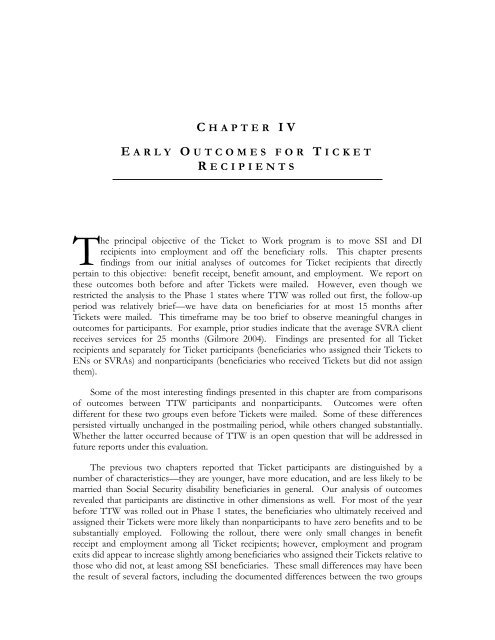Evaluation of the Ticket to Work Program, Implementation ...
Evaluation of the Ticket to Work Program, Implementation ...
Evaluation of the Ticket to Work Program, Implementation ...
You also want an ePaper? Increase the reach of your titles
YUMPU automatically turns print PDFs into web optimized ePapers that Google loves.
C HAPTER IVE ARLY O UTCOMES FOR T ICKETR ECIPIENTSThe principal objective <strong>of</strong> <strong>the</strong> <strong>Ticket</strong> <strong>to</strong> <strong>Work</strong> program is <strong>to</strong> move SSI and DIrecipients in<strong>to</strong> employment and <strong>of</strong>f <strong>the</strong> beneficiary rolls. This chapter presentsfindings from our initial analyses <strong>of</strong> outcomes for <strong>Ticket</strong> recipients that directlypertain <strong>to</strong> this objective: benefit receipt, benefit amount, and employment. We report on<strong>the</strong>se outcomes both before and after <strong>Ticket</strong>s were mailed. However, even though werestricted <strong>the</strong> analysis <strong>to</strong> <strong>the</strong> Phase 1 states where TTW was rolled out first, <strong>the</strong> follow-upperiod was relatively brief—we have data on beneficiaries for at most 15 months after<strong>Ticket</strong>s were mailed. This timeframe may be <strong>to</strong>o brief <strong>to</strong> observe meaningful changes inoutcomes for participants. For example, prior studies indicate that <strong>the</strong> average SVRA clientreceives services for 25 months (Gilmore 2004). Findings are presented for all <strong>Ticket</strong>recipients and separately for <strong>Ticket</strong> participants (beneficiaries who assigned <strong>the</strong>ir <strong>Ticket</strong>s <strong>to</strong>ENs or SVRAs) and nonparticipants (beneficiaries who received <strong>Ticket</strong>s but did not assign<strong>the</strong>m).Some <strong>of</strong> <strong>the</strong> most interesting findings presented in this chapter are from comparisons<strong>of</strong> outcomes between TTW participants and nonparticipants. Outcomes were <strong>of</strong>tendifferent for <strong>the</strong>se two groups even before <strong>Ticket</strong>s were mailed. Some <strong>of</strong> <strong>the</strong>se differencespersisted virtually unchanged in <strong>the</strong> postmailing period, while o<strong>the</strong>rs changed substantially.Whe<strong>the</strong>r <strong>the</strong> latter occurred because <strong>of</strong> TTW is an open question that will be addressed infuture reports under this evaluation.The previous two chapters reported that <strong>Ticket</strong> participants are distinguished by anumber <strong>of</strong> characteristics—<strong>the</strong>y are younger, have more education, and are less likely <strong>to</strong> bemarried than Social Security disability beneficiaries in general. Our analysis <strong>of</strong> outcomesrevealed that participants are distinctive in o<strong>the</strong>r dimensions as well. For most <strong>of</strong> <strong>the</strong> yearbefore TTW was rolled out in Phase 1 states, <strong>the</strong> beneficiaries who ultimately received andassigned <strong>the</strong>ir <strong>Ticket</strong>s were more likely than nonparticipants <strong>to</strong> have zero benefits and <strong>to</strong> besubstantially employed. Following <strong>the</strong> rollout, <strong>the</strong>re were only small changes in benefitreceipt and employment among all <strong>Ticket</strong> recipients; however, employment and programexits did appear <strong>to</strong> increase slightly among beneficiaries who assigned <strong>the</strong>ir <strong>Ticket</strong>s relative <strong>to</strong>those who did not, at least among SSI beneficiaries. These small differences may have been<strong>the</strong> result <strong>of</strong> several fac<strong>to</strong>rs, including <strong>the</strong> documented differences between <strong>the</strong> two groups
















